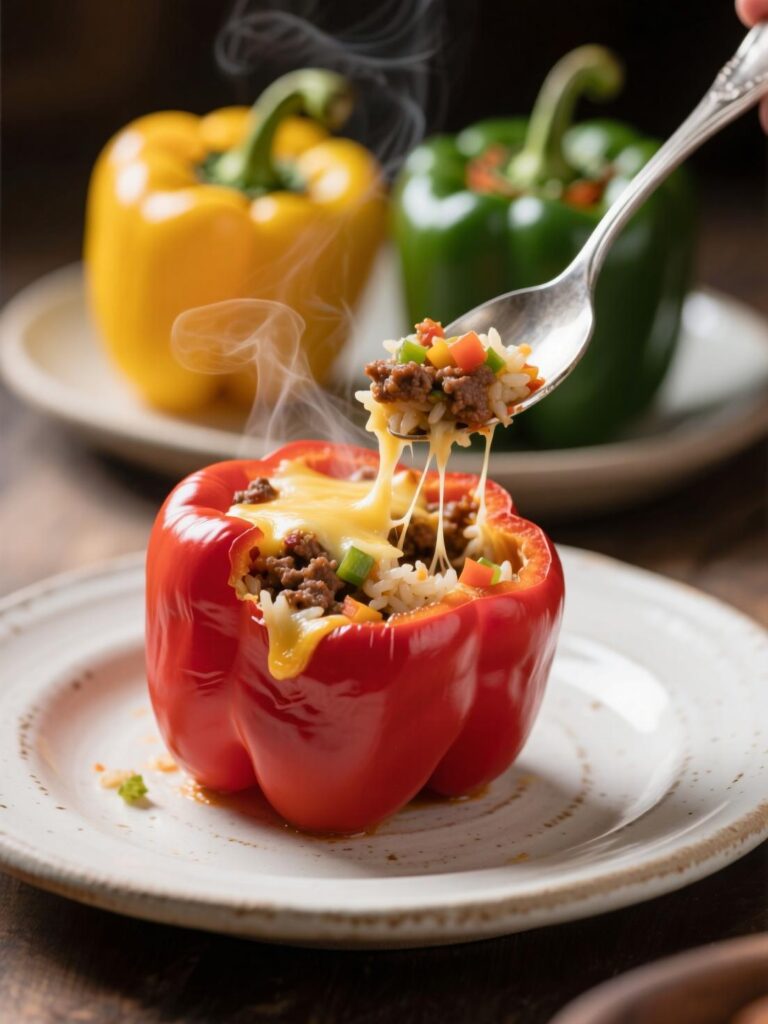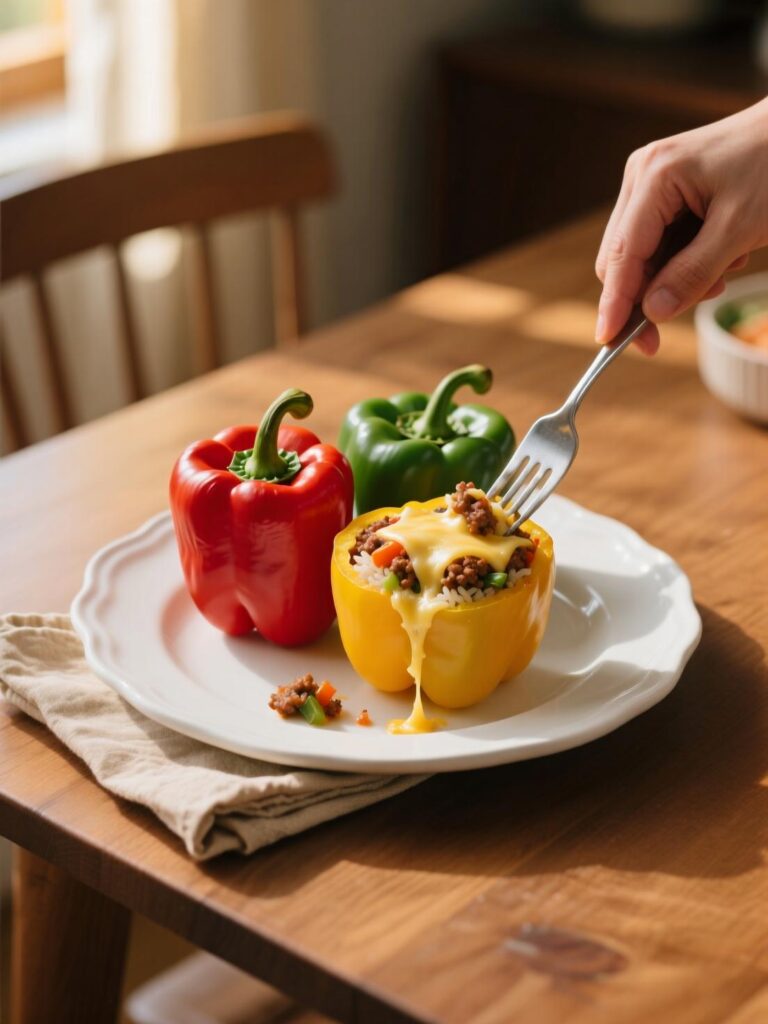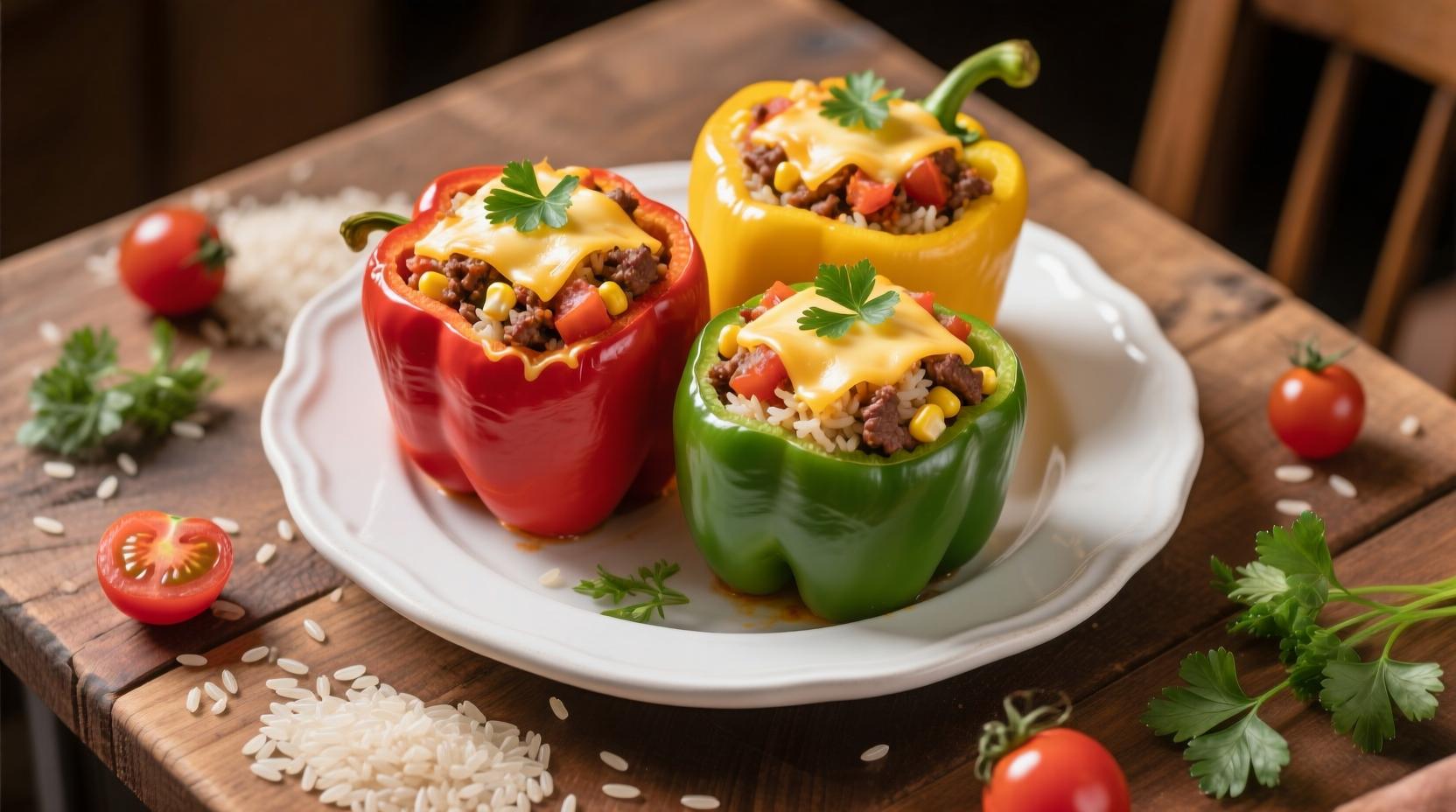There’s a reason stuffed bell peppers have never really gone away. They’re simple, yes, but in the right hands, they can be a culinary showpiece. Even seasoned chefs still tweak, test, and sometimes argue over what truly makes the perfect one. This isn’t just another homey recipe — it’s a dish that, when done well, carries a layered complexity hidden behind a humble shell of sweet pepper.
I’ve seen stuffed peppers land in the fine-dining arena and hold their ground against far more pretentious plates. Why? Because they offer structure, contrast, and flavor versatility that’s hard to replicate. The vessel is edible, colorful, and carries the aromas of its filling into every bite.
Understanding the Pepper as a Vessel
The bell pepper is not just a container — it’s part of the flavor equation. Its natural sugars caramelize slightly during roasting, creating a gentle sweetness that complements bold fillings. You want peppers that stand upright without rolling around the pan like they’ve got somewhere better to be. Select ones with thick walls; thin-skinned peppers collapse too easily under heat, losing the satisfying bite.
Color matters. Red peppers are the sweetest, yellow and orange hit a middle ground, and green brings an earthy, slightly bitter edge. If you’re working with high-fat meats or richer fillings, green peppers can balance them. If your stuffing is more delicate — say, a seafood risotto — go for red or yellow for a softer finish.
Prepping the Peppers — The Step Too Many Rush
I’ve seen even skilled cooks make the mistake of skipping the par-cooking stage. Raw peppers stuffed with filling and baked together often result in underdone shells or overcooked interiors. The fix? Par-roast or par-boil. Roasting develops depth, boiling keeps it clean and fresh.
For a richer profile, I always go with roasting. A quick 8–10 minutes in a 400°F oven softens them enough while coaxing out those sugars. That light char on the edges is a flavor signal that whispers “professional kitchen.”

The Filling — Where Chefs Get Creative
Classic fillings blend rice, ground meat, aromatics, and herbs. But those rules aren’t carved in stone. Professionals lean into regional inspiration. Greek-style with lamb, cinnamon, pine nuts, and feta. Spanish with chorizo, smoked paprika, and saffron rice. Japanese fusion with miso pork and sticky sushi rice.
Protein choice changes everything. Ground beef is traditional but can taste heavy if not balanced with acidity or herbs. Turkey and chicken give a lighter canvas. Plant-based fillings with lentils, farro, and mushrooms can rival meat versions when seasoned properly — umami is your friend here.
Chefs often consider moisture control above all else. Too wet and you’ve got a soggy mess. Too dry and the texture turns crumbly. Cook grains to just shy of done before mixing — they’ll finish in the pepper. Pre-cook proteins to drive off excess water or fat.
Aromatics, Seasonings, and Layering Flavor
The sauté stage for onions, garlic, and other aromatics isn’t just a prep step — it’s a foundation. Caramelizing onions deepens sweetness, while slow-cooked garlic loses sharpness and melts into the mix. I often throw in diced celery or fennel for a bit of texture and freshness.
Seasoning needs restraint but also intention. Stuffed peppers aren’t the place for “everything in the spice rack.” Choose 2–3 strong flavor drivers and let them lead. Herbs like thyme, oregano, or parsley offer familiar warmth. Spices like cumin or coriander shift the profile toward North African or Middle Eastern.
Binding Without Making a Brick
One common pitfall is overbinding. Too much cheese or egg and your filling becomes dense. The goal is cohesion, not compression. A small amount of beaten egg helps grains and meat hold together without turning heavy. Cheese works best as a layer within the filling or as a topping.
Some chefs ditch egg entirely and use tomato purée or a light béchamel to bind. The acidity from tomato also balances richness. This is why many Italian-style stuffed peppers bake in a shallow pool of tomato sauce — it hydrates the base and infuses flavor upward.
Cooking Technique — Getting That Perfect Bite
Temperature and time are critical. Most fillings are already cooked or partially cooked, so the bake is about melding flavors and finishing textures. Around 375°F for 20–30 minutes works for most variations. Covering for the first half keeps moisture in; uncovering at the end allows browning.
Avoid overbaking. The pepper should still hold its shape, with a slight give when cut. Mushy peppers mean either too much bake time or too much pre-cooking. Professionals often stagger components — filling hot, peppers slightly undercooked — so both reach perfect doneness together.
Plating — Yes, It Matters
A stuffed pepper sliced in half diagonally, showing off the colorful filling, has more visual appeal than serving it whole. A drizzle of sauce around the plate, maybe a scattering of fresh herbs, elevates presentation instantly. Even at casual service, appearance sells the dish before the first bite.
For catering or banquets, mini bell peppers are gold. They hold smaller portions, cook faster, and look vibrant in large arrangements. I’ve seen entire appetizer menus built around “one-bite” stuffed peppers with fillings ranging from goat cheese and herbs to spicy shrimp.
Trends in Professional Kitchens
Modern stuffed peppers often go lighter and fresher than the heavy 1970s versions. Chefs are leaning toward grains like quinoa, bulgur, and wild rice for texture variety. Plant-forward fillings are growing, especially those using roasted vegetables and legumes with global spice blends.
Fermented ingredients are showing up, too — kimchi-stuffed peppers with pork and scallion rice have a tangy punch. Smoked elements, like chipotle in adobo or smoked salt, add a layer of intrigue without overpowering.
Common Mistakes Even Pros Make
Overstuffing is one. A tightly packed filling can’t expand, so it either splits the pepper or comes out dense. Leave just enough space for the filling to breathe. Underseasoning is another — remember that the pepper itself is mild; the filling must carry enough flavor for the whole bite.
Relying solely on cheese to create interest is also a trap. Cheese is a garnish, not a crutch. If your filling is bland without it, the balance isn’t right.

Nutrition and Menu Considerations
Stuffed bell peppers can be built to suit nearly any dietary need. Gluten-free? Use rice, quinoa, or buckwheat. Low-carb? Swap grains for riced cauliflower. Vegan? Lentils, mushrooms, and nuts create a hearty, satisfying profile without animal products.
They also work beautifully for make-ahead service. You can assemble them hours before, refrigerate, then bake to order. Just be mindful that cold fillings need longer bake times — and that can overcook the pepper if you’re not careful.
The Professional Edge — Tiny Tweaks That Matter
Brush the inside of the pepper lightly with oil and seasoning before stuffing. This seasons the pepper itself and helps prevent sticking. Toasting grains before cooking adds a nutty undertone. Deglazing your filling pan with wine or stock captures all those fond bits that carry huge flavor.
One of my favorite touches is adding a textural element on top — toasted breadcrumbs, crushed nuts, or seeds. That slight crunch against the softness of the filling and pepper gives the dish an addictive finish.
Conclusion — The Dish That Keeps Giving
Stuffed bell peppers might look humble, but they’re one of those dishes that reward skill and attention at every stage. The ingredient choices, the prep, the timing, the plating — each step is a chance to turn simple into spectacular.
For professionals, the challenge isn’t making them edible. It’s making them unforgettable. And when a guest cuts through that pepper and the aroma escapes, you know you’ve done it right.
If you want, I can also prepare a professional stuffed bell peppers recipe tailored for fine dining presentation, with exact chef-grade ratios and plating suggestions. That would give you both the theory and the execution to match. Would you like me to do that next?
FAQs
What type of bell pepper is best for stuffing?
Thick-walled peppers that stand upright, with color chosen based on desired flavor profile, work best.
Should I cook the peppers before stuffing?
Yes, par-roasting or par-boiling helps soften them and improves texture.
What are some protein options for stuffed peppers?
Beef, chicken, turkey, lamb, seafood, or plant-based proteins like lentils and mushrooms.
How do I prevent stuffed peppers from getting soggy?
Use pre-cooked fillings with controlled moisture and avoid overbaking.
Can stuffed peppers be made ahead of time?
Yes, they can be assembled in advance and baked before serving.
How long should stuffed peppers bake?
Around 20–30 minutes at 375°F, depending on filling and pepper size.
Do I need to cover stuffed peppers while baking?
Yes, cover for the first half to retain moisture, then uncover to brown.
What grains work best for fillings?
Rice, quinoa, bulgur, farro, or wild rice add structure and texture.
How do I add extra flavor to the peppers themselves?
Lightly season and oil the insides before stuffing.
Are stuffed peppers suitable for special diets?
Yes, they can be made gluten-free, vegan, low-carb, or high-protein.

Mariana is a passionate home cook who creates delicious, easy-to-follow recipes for busy people. From energizing breakfasts to satisfying dinners and indulgent desserts, her dishes are designed to fuel both your body and hustle.
When she’s not in the kitchen, she’s exploring new flavors and dreaming up her next recipe to share with the Foodie Hustle community.

